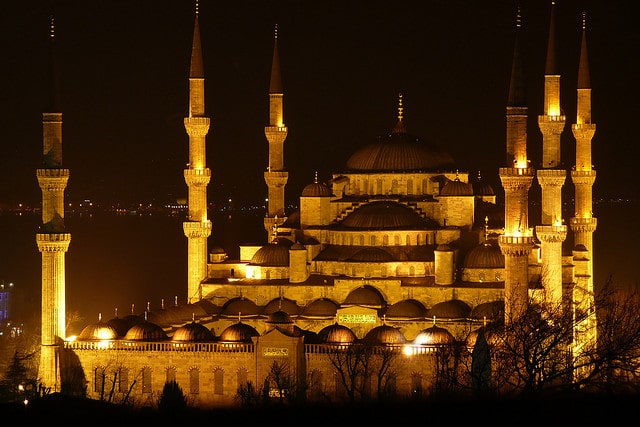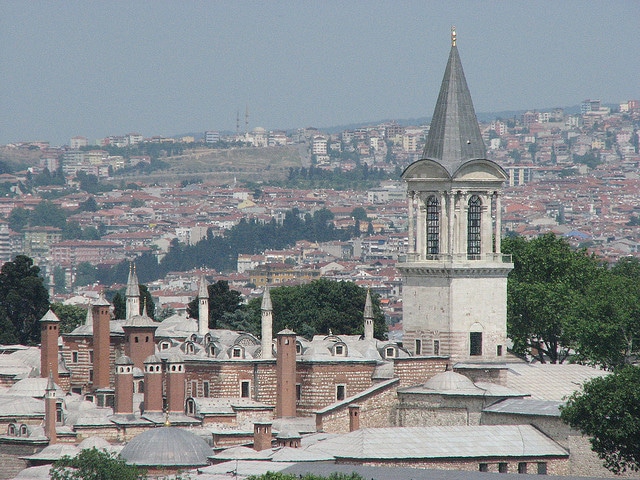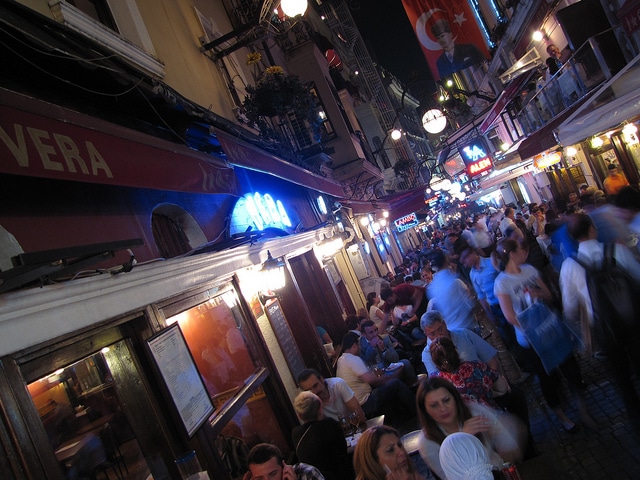A gateway between Europe and Asia, Istanbul has a unique place in the world. It has been the beacon of Christianity as the Byzantine city Constantinople, as well as the former capital of the Ottoman Empire. Now a busy, metropolitan and vibrant place to visit, Istanbul attracts tourists from across the world. Crammed with mosques, palaces, restaurants, shops and museums; this is a city that yearns to be discovered. There is nowhere in the world that has the same mix of East and West, of Muslim heritage in a secular country, where taxis zigzag through heavy traffic and yet peaceful tranquillity is never hard to find.
First time visitors can often be overwhelmed with what Istanbul has to offer. Its history, food, culture, and nightlife makes it hard to prioritise what to see and do. To get you started here are six things not to be missed when visiting this city.
1. The Blue Mosque
One of the most famous landmarks in Istanbul, the Sultan Ahmed Mosque, which is popularly known as the Blue Mosque, was built between 1609 and 1615 and is still used as a place of worship.

This is an important landmark, as it is a demonstration of traditional Islamic architecture and considered the last great mosque to be built during the classic period. Sultan Ahmed Mosque was given the nickname Blue Mosque because of the blue tiles that adorns its interior walls.
2. The Grand Bazaar
One of the largest, and oldest, covered markets in the world, The Grand Bazaar is a shoppers paradise. Its 60 ‘streets’ create a burrow like maze, which tourists and residents navigate through to discover its 5,000 shops and restaurants. The Grand Bazaar is well known for its leather, gold jewellery, carpets, embroideries, spices and antique shops – plus it is a great place for visitors to try out their haggling skills.

Along with its shops, The Grand Bazaar is also rich with history. It was originally built in the 1400s on the order of Sultan Mehmed the Conqueror and has been an important trading centre since 1461. In the 16th Century, during the reign of Sultan Suleiman the Magnificent, the complex was vastly enlarged and in 1894 it underwent a major restoration following an earthquake.
3. Topkapi Palace Museum
The official residence of the Sultan for nearly 400 years, the Topkapi Palace Museum gives visitors a glimpse into the wealth and grandeur the Ottoman elite enjoyed during their 624-year reign. At its height of power the Ottoman Empire stretched from Austria in Europe, across North Africa and throughout the Middle East; and the Sultan benefited from the wealth this vast territory brought.

The palace was originally built by Sultan Mehmed II in the 1400s, however it was added onto throughout its history, with major renovations taking place in 1509 and 1665. The palace was once home to 4,000 people and included mosques, bakeries, and a mint, along with the harem. It fell from favour in the early 1800s as the royal family preferred to spend time at their other palaces, and in 1856 the court was moved to the newly built Dolmabahce Palace.
4. A Ferry to Asia
There is no other city in the world that enables you to have breakfast in Europe and lunch in Asia. Book a place on one of the many ferries transporting visitors across the Bosphorus River that divides East from West, and head away from the city to enjoy a peaceful lunch in Asia.

Since ancient Greek times, the Bosphorus River has always been an important waterway enabling goods to be transported from one culture to another. Still used as a major trading route today cruise liners, cargo ships and ferries jostle for places on the river.
5. Hagia Sophia
Once a Byzantine Church, then an Ottoman mosque and now a museum, Hagia Sophia has over 1,500 years of history. The original Hagia Sophia church was built by Constantine the Great, the first Christian emperor, however unfortunately nothing remains of this church. In 537 the church was rebuilt, and it is this building that forms the foundations of the present day Hagia Sophia. The church became a mosque after Sultan Mehmet the Conqueror rode triumphantly into the city and was said to be so impressed with the building that he immediately converted it into his imperial mosque.

After the fall of the Ottoman Empire the mosque was turned into a museum and visitors can see both Christian architecture and artwork together with Islamic mosaics.
6. The nightlife
Turkey may be a predominantly Muslim country, but its relaxed laws means that drinking and partying are part of the social scene for many young Istanbul residents. After a day spent visiting all those historic sites, once the sun goes down it is time to sample a taste of modern Turkey. Try heading to one of the many restaurants the city has to offer then perhaps onto a bar and a nightclub to dance the night away to a blend of European and Turkish pop music.

Written by Derin Clark a writer, editor and blogger who has travelled extensively around Europe and Turkey.
Istanbul photos: jo.schz, Horus3, kate.gardiner, buster&bubby, Martin Rohacek, karin.verhagen.














